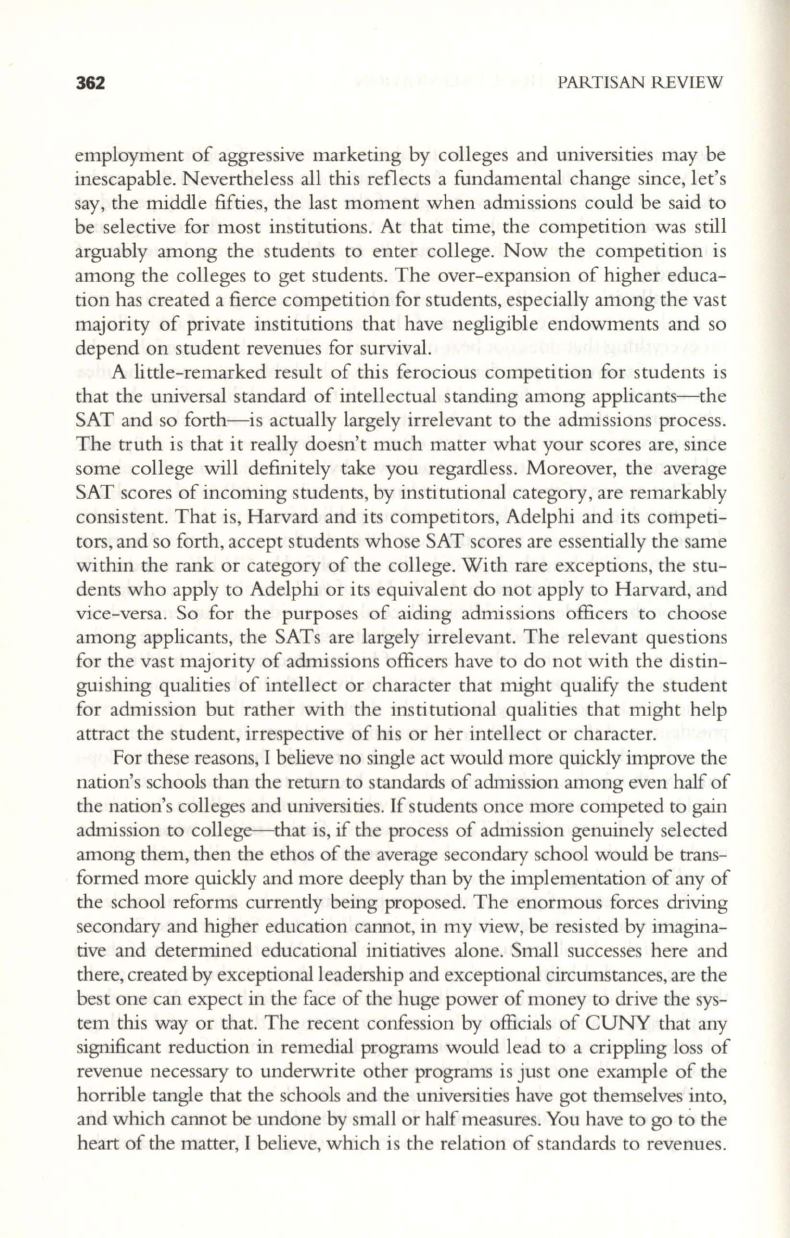
362
PARTISAN REVIEW
employment of aggressive marketing by colleges and universities may be
inescapable. Nevertheless all this reflects a fundamental change since, let's
say, the middle fifties, the last moment when admissions could be said to
be selective for most institutions. At that time, the competition was still
arguably among the students to enter college. Now the competition is
among the colleges to get students. The over-expansion of higher educa–
tion has created a fierce competition for students, especially among the vast
majority of private institutions that have negligible endowments and so
depend on student revenues for survival.
A litde-remarked result of this ferocious competition for students is
that the universal standard of intellectual standing among applicants-the
SAT and so forth-is actually largely irrelevant to the admissions process.
The truth is that it really doesn't much matter what your scores are, since
some college will definitely take you regardless. Moreover, the average
SAT scores of incoming students, by institutional category, are remarkably
consistent. That is, Harvard and its competitors, Adelphi and its competi–
tors, and so forth, accept students whose SAT scores are essentially the same
within the rank or category of the college. With rare exceptions, the stu–
dents who apply to Adelphi or its equivalent do not apply to Harvard, and
vice-versa. So for the purposes of aiding admissions officers to choose
among applicants, the SATs are largely irrelevant. The relevant questions
for the vast majority of admissions officers have to do not with the distin–
guishing qualities of intellect or character that might qualifY the student
for admission but rather with the institutional qualities that might help
attract the student, irrespective of his or her intellect or character.
For these reasons, I believe no single act would more quickly improve the
nation's schools than the return to standards of admission among even half of
the nation's colleges and universities. If students once more competed to gain
admission to college--that is,
if
the process of admission genuinely selected
among them, then the ethos of the average secondary school would be trans–
formed more quickly and more deeply than by the inlplementation of any of
the school reforms currendy being proposed. The enormous forces driving
secondary and higher education cannot, in my view, be resisted by imagina–
tive and determined educational initiatives alone. Small successes here and
there, created by exceptional leadership and exceptional circumstances, are the
best one can expect in the face of the huge power of money to drive the sys–
tem this way or that. The recent confession by officials of CUNY that any
significant reduction in remedial programs would lead to a crippling loss of
revenue necessary to underwrite other programs is just one example of the
horrible tangle mat me schools and me universities have got themselves into,
and which cannot be undone by small or half measures. You have to go to me
heart of the matter, I believe, which is the relation of standards to revenues.


